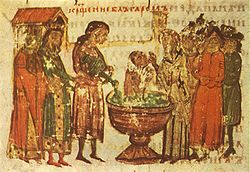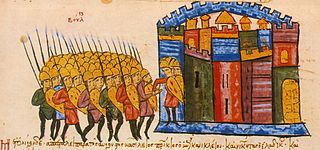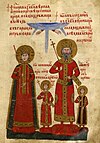Christianization of Bulgaria
This process was characterized by the shifting political alliances of Boris I of Bulgaria (ruled 852–889) with the kingdom of the East Franks and with the Byzantine Empire, as well as his diplomatic correspondence with the Pope.
When Khan Boris began his reign in 852, the international situation in Southeast Europe was characterized by a race for influence in the region, both cultural and political.
In the middle Danube region, Bulgaria's interests crossed with those of the emerging kingdom of the East Franks and the principality of Great Moravia.
Semi-Autonomous: Some time later, Khan Boris concluded an alliance with Rastislav of Moravia (846–870) instigated by the King of the West Franks, Charles the Bald (840–877).
The Byzantines wanted to regain control over some fortresses on the Diagonal Road (Via Diagonalis or Via Militaris) that went from Constantinople, through Philippopolis (Plovdiv), to Naissus (Niš) and Singidunum (Belgrade).
[1] In 861 Khan Boris concluded an alliance with East Frankish King Louis the German, all while informing him that he would like to accept Christianity according to western rite.
Cyril and his brother Methodius intended to draw Great Moravia closer to Constantinople and strengthen the Byzantine influence there.
Bulgaria wanted to implement the Slavonic alphabet as well as a means to stop the cultural influence of the Byzantine Empire.
Negotiations were set up and Boris promised to convert to Eastern Orthodox Christianity along with his people, requesting missionaries to come to Bulgaria and begin the process.
In the late autumn of 864, a mission from the Patriarch of Constantinople Photios arrived at the Bulgarian capital Pliska and converted the Khan, his family and high-ranking dignitaries.
Since both of these states were Christian, Pagan Bulgaria remained more or less in isolation, unable to interact on even grounds, neither culturally nor religiously.
The preservation of paganism among the Bulgars and the Slavs, the ethnic groups that formed, along with the local, Romanized (later called Vlachs) or Hellenized Christian Thracian population, the Bulgarian people and nation brought another disadvantage — the pagan and Christian ethnic groups' unification was hampered by their different religious beliefs.
In 865, malcontents from all ten administrative regions (komitats) revolted against Knyaz Boris, accusing him of giving them "a bad law".
Until the end of his life, Knyaz Boris was haunted by guilt about the harshness of killing the sons of the revolt's leaders and the moral price of his decision in 865.
[citation needed] Different interpretations of the historical records have led some historians to believe the Knyaz executed almost half the Bulgarian aristocracy to end the religious and political conflict.
At this time during the Middle Ages, Bulgarians considered "Christians" as equivalent to their traditional competitors the "Byzantines", or "Greeks", as they were most often called.
At the end of August 866, a Bulgarian mission led by the kavhan Peter arrived in Rome, carrying a list of 115 questions from Knyaz Boris.
In a letter to Knyaz Boris, the Byzantine emperor expressed his disapproval of Bulgaria's religious reorientation by using offensive language against the Roman Church.
A religious council was held in the summer of 867 in the Byzantine capital, during which clerics criticized the Roman Church's actions of recruiting Bulgaria.
His successor, Pope Adrian II (867-872), also failed to respond to Knyaz Boris' request for appointment of a Bulgarian archbishop.
After he had a three-day stay in Pliska, the Bulgarians sent him back to Rome accompanied by emissaries carrying a letter of complaint by Knyaz Boris.
Boris perceived Rome's refusals of his request and delays as an insult and a sign of the Pope's unwillingness to coordinate selection with him of a Bulgarian archbishop.
But, on 23 September 867, Emperor Michael III was killed by his close acquaintance Basil, who established the Macedonian dynasty that ruled the Empire until 1057.
Over the next 10 years, Pope Adrian II and his successors made desperate attempts to regain their influence in Bulgaria and to persuade Knyaz Boris to leave Constantinople's sphere.
The conversion of the Bulgarians to Christianity and the establishment of the Bulgarian national Church coincided with the unprecedented cultural prosperity in Bulgaria which had begun in 855 AD with the adopting of the disciples of Saints Cyril and Methodius' alphabet, who under the patronage of Knyaz Boris implemented for the first time, the Cyrillic alphabet and established literary schools in Pliska and Ohrid.






